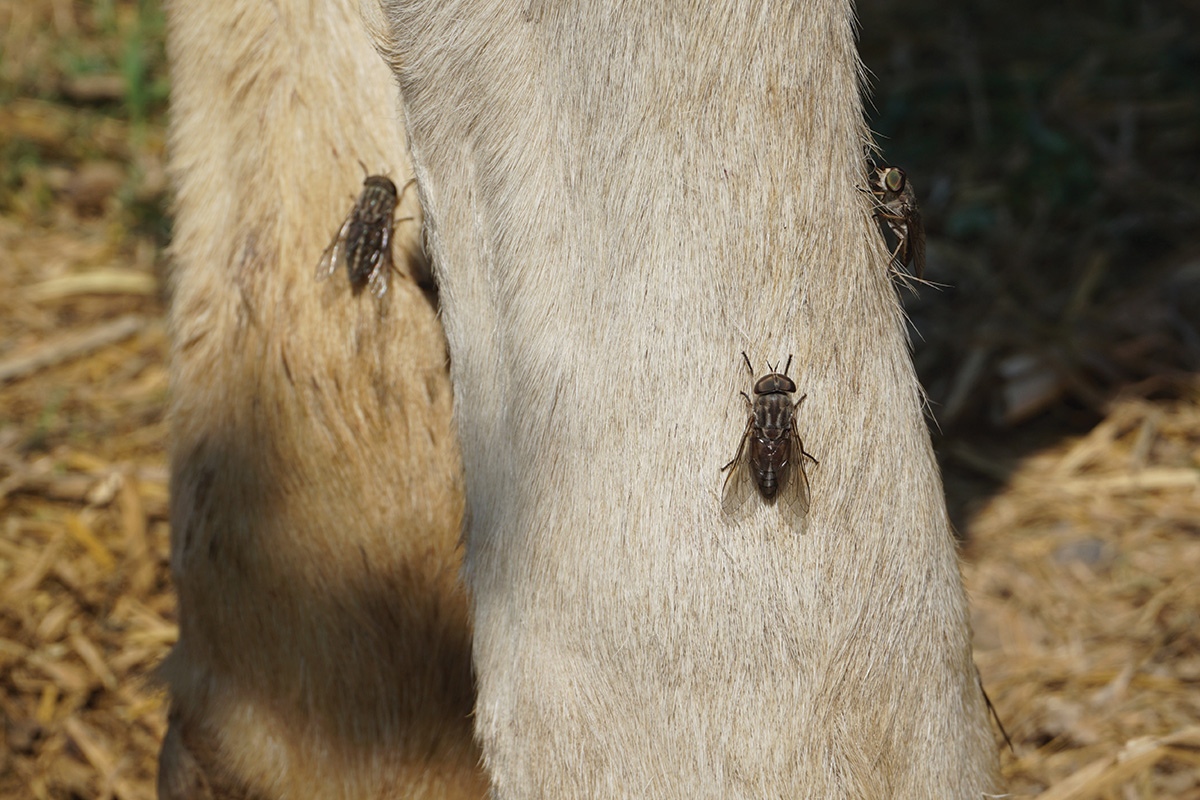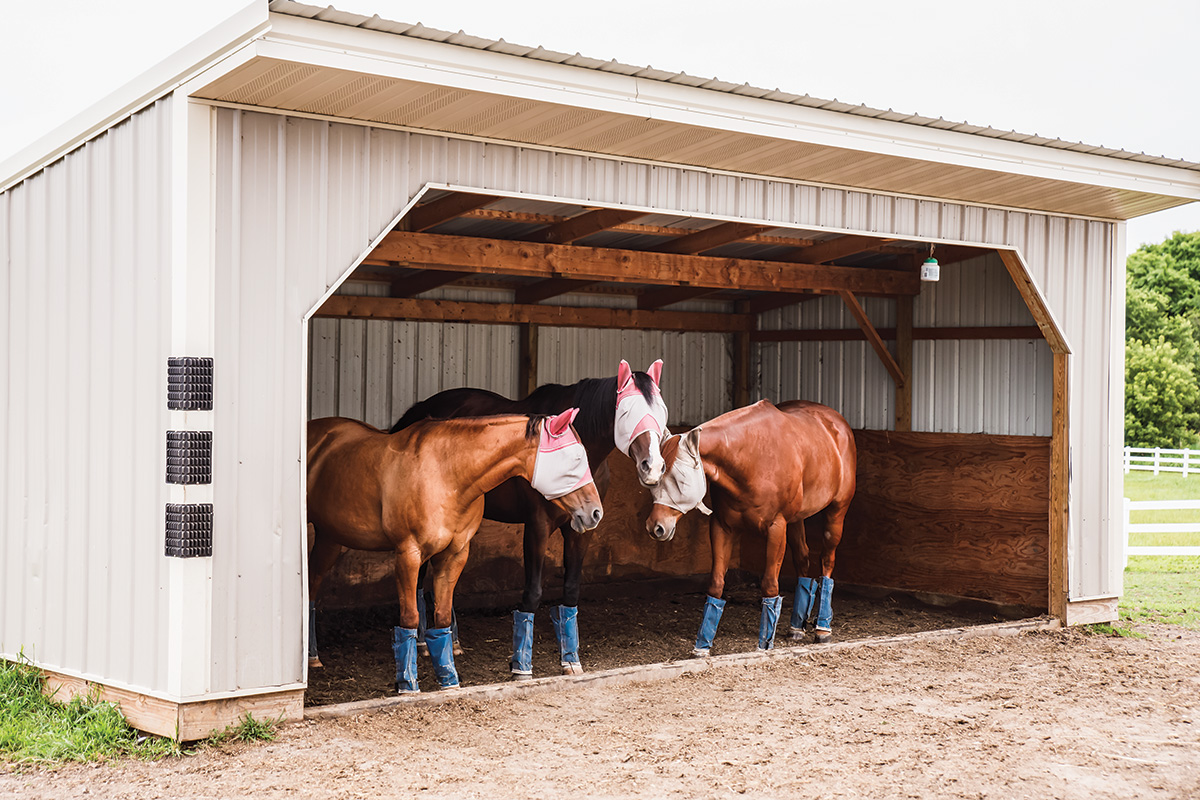It’s summer. Just listen: tractors, songbirds, bullfrogs, and a chorus of earth-shaking hoof stomps are the sounds of summer around a farm. If there’s one sound we all recognize, it is that repetitive thud … thud … thud of horses stomping their hooves against the ground to repel an annoying fly.


That symphony of stomps you hear as you approach your horse’s pasture can be an ominous warning sign of hoof problems to come. If you start to see hoof health deteriorate as summer progresses, you may soon be facing increased farrier bills and even a horse that need time off.
Be a Keen Observer
What’s a horse owner to do? First, make a plan—but make it early in the summer, before the flies take over.
The first step is to understand that the sound of a horse stomping the ground may mean different things, and you must be dedicated to checking your horse several times a day.
Stomping at flies is a normal reaction for horses when flies buzz around and land on lower legs. But a horse will also stomp the ground if he has unearthed a wasp’s nest or biting-ant hill in the ground; he may need your help, especially in a small pen.
Likewise, a horse may be nervously pawing the ground, not stomping. If you hear the sound of stomping when you shouldn’t, don’t assume that your horse is reacting to flies. Always investigate unusual sounds coming from a pen or pasture.
Next, learn what is “normal” for flies in your area and on your farm. Some areas cycle through different types and densities of flies over the course of the summer.

Flies may bother horses more or less at different times of the day, or in different weather conditions. Make notes about what you notice about the flies around your horse and around your barn, in general. If your horse prefers a certain part of a paddock, it may be because there are fewer flies or the ground is softer and pounding isn’t so jarring.

If your horse is sensitive to biting flies, have topical astringents and healing ointments on hand to dab broken skin and welts. Exposed wounds on the lower legs will attract even more flies. Be prepared to call your vet if sudden swelling occurs.
Learn all you can about horse behavior in the pasture. Horses can become habitual stompers, and tales are told of fly-weary horses who kept on stomping even on windy days when no flies bothered their legs.
Fly Stomping Causes Problems for Feet
Fly stomping can wreak havoc on hooves. Shod horses may experience raised clinches, a loosening of the nails’ grip on the hoof wall. The clinches may suddenly feel rough to the touch.
Ragged clinches may cause cuts and scrapes on the hands and thighs of riders and grooms who pick up hooves for cleaning, and rip or catch on an expensive pair of breeches. They’re another good reason to wear long pants around horses in the summer.
Loose shoes are a special danger when horses are shod with clips. Clips prevent shoes from shifting, but a horse can step down on a loose shoe’s clip and damage his hoof wall or sole. A shoe that comes completely off is a danger to all the horses in a pasture, since any of them can step on its exposed nails or protruding clips.
Frayed “potato chip” feet are common in the summer and worsen as fall approaches. Stomping at flies may make brittle hoof walls worse.
Superficial wall cracks are also common in stomping horses, but a crack that penetrates the wall requires the attention of a farrier. It may worsen over the course of the summer if the horse is stomping repeatedly.
Notify your farrier if you see problems developing so they can be treated before resulting in lameness or requiring special shoeing.
Fighting Off Flies
Horses have their pet peeves. One hates wearing leg wraps. Another fears the sound of sprays and won’t stand still for application. Learn each horse’s fly-related idiosyncrasies, inform everyone who cares for the horse, and find workarounds so every horse has as ideal protection from flies as possible to prevent fly stomping.
What’s in your fly spray? Respect anyone around your barn—whether horse or human—who may be sensitive to fly-control chemicals.

Know how much and how often products should be used. Your paddock fly-control practices should suit the severity of your problem, your horse’s turnout schedule, and your environmental priorities.
10-Step Plan to Eliminate Foot Problems Related to Fly Stomping
1. Think ahead. Keep a calendar and mark when the flies start appearing, what times of day they are the worst, and dates when you notice different types and densities of flies and mosquitoes. Also mark days for manure removal. Likewise, make note of weather, and notice paddock areas that have more or fewer stomping horses.
2. Check each foot on your horse before and after turnout. Look for loose or sprung clinches, bent or gaping shoes, and traces of dried blood that indicate stomp-related skin damage. Examine the insides of legs and pasterns.
3. Try using fly boots. If using repellent, too, apply to both the inside and the outside of the leg from the knee or hock down.

4. Don’t turn out horses near manure piles in summer. Remember that flies love manure, so a horse’s feet and lower legs are already often in close range for a fly. Be diligent about picking out your paddocks so you can deprive flies of the manure they seek.
5. Walk your pastures and look for lost shoes. If you find one, note the location and date found and the name of the horse, if known. Check that horse for hoof damage. Your farrier may be able to re-use the found shoe if it’s in good shape.
6. Quickly address shoes that are partially detached. First, call your farrier. You may be instructed to secure the shoe with duct tape or cover the entire foot with Vetrap and keep the horse in a stall until it can be fixed.
7. Learn to remove a loose or bent shoe. If you’re unsure how to do this, purchase a basic set of farrier tools and ask your farrier to teach you. Store the tools in a clean, dry place and don’t use them for anything but horseshoes.
8. Have your horse on a regular trimming or shoeing schedule. Six weeks is normal, but some horses may need shorter intervals, especially in summer. Don’t be tempted to skip or reschedule an appointment in the summer. Overgrown feet and worn shoes that are left on too long put a horse at risk.
9. Not stomping may be a problem, too. Senior horses, laminitics, or ringbone sufferers will especially appreciate diligent lower-leg fly defense. Is there a horse that’s not stomping at the flies, even though he’s in the same paddock with horses who are? It’s possible that the horse is in pain and doesn’t want to slam a sore foot onto the ground.
10. Stomping feet may be only part of the problem. Make sure your horse is up to date on vaccinations for insect-related diseases. A variety of serious infectious horse diseases are carried by horse flies and mosquitoes.
Flies are a fact of life around horses in the summer. They are a nuisance, but they can also cause problems that will gradually compromise a horse’s wellbeing. Horses instinctively stomp their feet when they sense flies.
Your horse will thank you for stopping the stomp before his hooves are damaged.
This article about fly stomping affecting hooves appeared in the July 2022 issue of Horse Illustrated magazine. Click here to subscribe!





